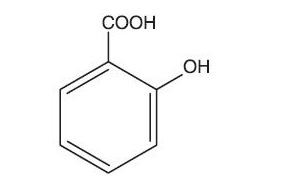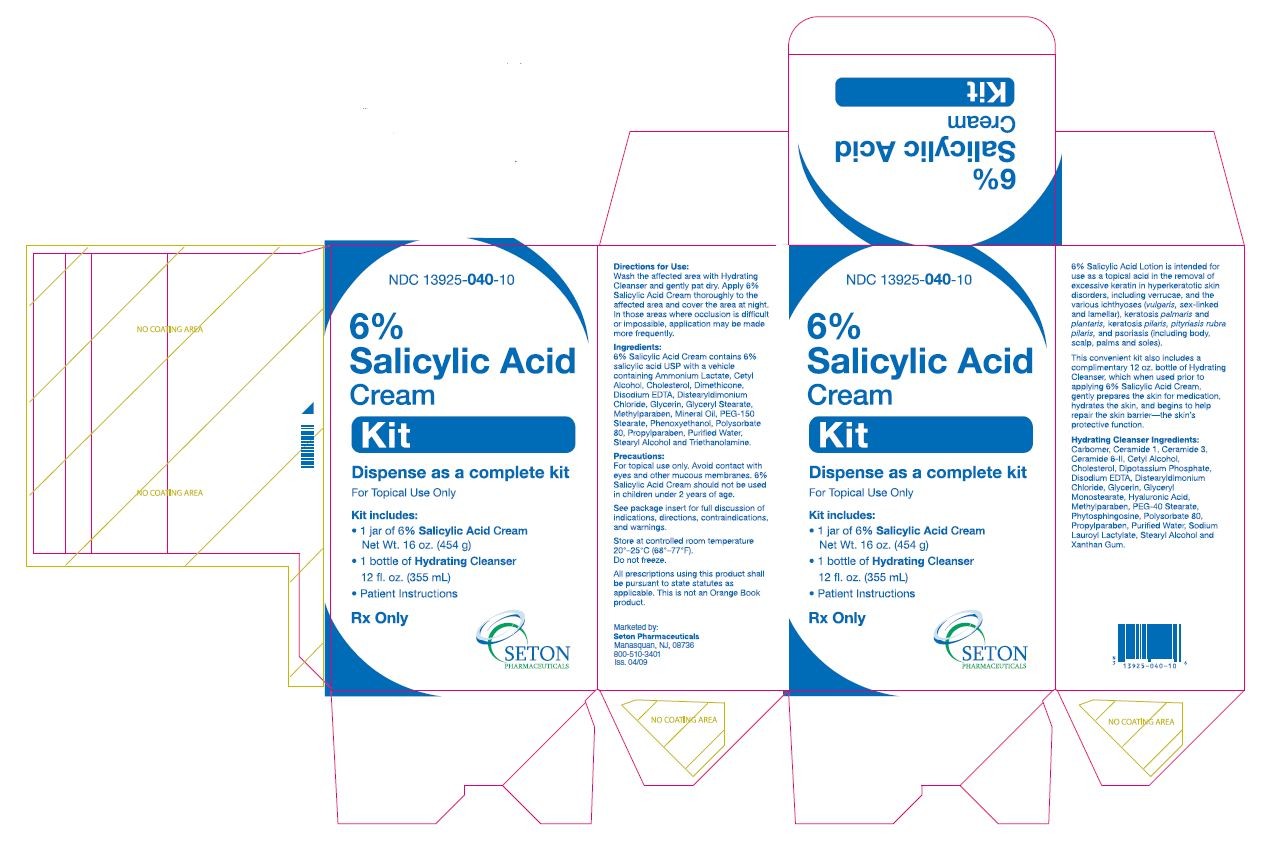Salicylic Acid
6% Salicylic Acid Cream 6% Salicylic Acid Lotion
FULL PRESCRIBING INFORMATION: CONTENTS*
- SALICYLIC ACID DESCRIPTION
- CLINICAL PHARMACOLOGY
- SALICYLIC ACID INDICATIONS AND USAGE
- SALICYLIC ACID CONTRAINDICATIONS
- WARNINGS
- 6% Salicylic Acid
- Hydrating
- PRECAUTIONS
- SALICYLIC ACID ADVERSE REACTIONS
- OVERDOSAGE
- SALICYLIC ACID DOSAGE AND ADMINISTRATION
- HOW SUPPLIED
- PRINCIPAL DISPLAY PANEL - Cream Kit
FULL PRESCRIBING INFORMATION
Rx Only
FOR DERMATOLOGIC USE ONLY. NOT FOR OPHTHALMIC, ORAL OR INTRAVAGINAL USE.
SALICYLIC ACID DESCRIPTION
6% Salicylic Acid Cream contains 6% salicylic acid USP with a vehicle containing Ammonium Lactate, Cetyl Alcohol, Cholesterol, Dimethicone, Disodium EDTA, Distearyldimonium Chloride, Glycerin, Glyceryl Stearate, Methylparaben, Mineral Oil, PEG-150 Stearate, Phenoxyethanol, Polysorbate 80, Propylparaben, Purified Water, Stearyl Alcohol and Triethanolamine.
6% Salicylic Acid Lotion contains 6% w/w salicylic acid USP in a vehicle consisting of Ammonium Lactate, Cetearyl Alcohol, Cetyl Alcohol, Cholesterol, Disopropyl Adipate, Dimethicone, Disodium EDTA, Distearyldimonium Chloride, Glycerin, Glyceryl Stearate, Methylparaben, Mineral Oil, PEG-150 Stearate, Phenoxyethanol, Polysorbate 80, Propylparaben, Purified Water and Triethanolamine. Salicylic acid is the 2-hydroxy derivative of benzoic acid having the following structure:

CLINICAL PHARMACOLOGY
Salicylic acid has been shown to produce desquamation of the horny layer of skin while not effecting qualitative or quantitative changes in the structure of the viable epidermis. The mechanism of action has been attributed to a dissolution of intercellular cement substance. In a study of the percutaneous absorption of salicylic acid in a 6% salicylic acid gel in four patients with extensive active psoriasis, Taylor and Halprin showed that the peak serum salicylate levels never exceeded 5 mg/100 mL even though more than 60% of the applied salicylic acid was absorbed. Systemic toxic reactions are usually associated with much higher serum levels (30 to 40 mg/100 mL). Peak serum levels occurred within five hours of the topical application under occlusion. The sites were occluded for 10 hours over the entire body surface below the neck. Since salicylates are distributed in the extracellular space, patients with a contracted extracellular space due to dehydration or diuretics have higher salicylate levels than those with a normal extracellular space. (See PRECAUTIONS.)
The major metabolites identified in the urine after topical administration are salicyluric acid (52%), salicylate glucuronides (42%) and free salicylic acid (6%). The urinary metabolites after percutaneous absorption differ from those after oral salicylate administration; those derived from percutaneous absorption contain more salicylate glucuronides and less salicyluric and salicylic acid. Almost 95% of a single dose of salicylate is excreted within 24 hours of its entrance into the extracellular space.
Fifty to eighty percent of salicylate is protein bound to albumin. Salicylates compete with the binding of several drugs and can modify the action of these drugs; by similar competitive mechanisms other drugs can influence the serum levels of salicylate. (See PRECAUTIONS.)
SALICYLIC ACID INDICATIONS AND USAGE
For Dermatologic Use: 6% Salicylic Acid is a topical aid in the removal of excessive keratin in hyperkeratotic skin disorders, including verrucae, and the various ichthyoses (vulgaris, sex-linked and lamellar), keratosis palmaris and plantaris, keratosis pilaris, pityriasis rubra pilaris, and psoriasis (including body, scalp, palms and soles).
For Podiatric Use: 6% Salicylic Acid is a topical aid in the removal of excessive keratin on dorsal and plantar hyperkeratotic lesions. Topical preparations of 6% salicylic acid have been reported to be useful adjunctive therapy for verrucae plantares.
SALICYLIC ACID CONTRAINDICATIONS
6% Salicylic Acid should not be used in any patient known to be sensitive to salicylic acid or any other listed ingredients. 6% Salicylic Acid should not be used in children under 2 years of age.
WARNINGS
Prolonged and repeated daily use over large areas, especially in children and those patients with significant renal or hepatic impairment, could result in salicylism. Patients should be advised not to apply occlusive dressings, clothing or other occlusive topical products such as petrolatum-based ointments to prevent excessive systemic exposure to salicylic acid. Excessive application of the product other than is needed to cover the affected area will not result in a more rapid therapeutic benefit. Concomitant use of other drugs which may contribute to elevated serum salicylate levels should be avoided where the potential for toxicity is present. In children under 12 years of age and those patients with renal or hepatic impairment, the area to be treated should be limited and the patient monitored closely for signs of salicylate toxicity: nausea, vomiting, dizziness, loss of hearing, tinnitus, lethargy, hyperpnea, diarrhea, and psychic disturbances. In the event of salicylic acid toxicity, the use of 6% Salicylic Acid should be discontinued. Fluids should be administered to promote urinary excretion. Treatment with sodium bicarbonate (oral or intravenous) should be instituted as appropriate. Patients should be cautioned against the use of oral aspirin and other salicylate containing medications, such as sports injury creams, to avoid additional excessive exposure to salicylic acid. Where needed, aspirin should be replaced by an alternative non-steroidal anti-inflammatory agent that is not salicylate based.
Due to potential risk of developing Reye's syndrome, salicylate products should not be used in children and teenagers with varicella or influenza, unless directed by a physician.
6% Salicylic Acid
Cream & Lotion
Instructions for Best Results
For best treatment results, follow these step-by-step instructions every day. If you have any questions, please call your dermatologist.
- Cleanse
- Medicate
- Moisturize-if needed
Step 1. Cleanse:
If possible, soak the affected area in warm water for about 5 minutes. Then, wash the affected area with Hydrating Cleanser and gently pat dry.
Step 2. Medicate:
Apply 6% Salicylic Acid Cream or Lotion thoroughly to the affected area. Gently massage until 6% Salicylic Acid Cream or Lotion is evenly distributed.
Step 3. Moisturize - if needed:
If needed, apply a moisturizer to the affected area. Use a moisturizer like 6% Salicylic Acid Moisturizing Cream or Lotion that can help repair the skin barrier to maintain its protective function. Gently massage 6% Salicylic Acid Moisturizing Cream or Lotion into the affected area until all the Cream or Lotion is absorbed into the skin.
6% Salicylic Acid Cream or Lotion should not be used in any patient known to be sensitive to salicylic acid or any other listed ingredients. 6% Salicylic Acid Cream or Lotion should not be used in children under 2 years of age. Excessive erythema and scaling conceivably could result from use on open skin lesions.
Hydrating
Cleanser
Included is a complimentary 12 oz. bottle of Hydrating Cleanser
- Gently cleanses and prepares the skin for medication without causing further dryness and irritation to conditions like psoriasis and ichthyosis
- Continues to deliver skin-nourishing ingredients such as ceramides-even after rinsing that help repair the skin barrier to maintain its protective function
Remember to include Hydrating Cleanser in your daily treatment regimen. It is also an Ideal facial cleanser.
Cleanse before applying 6% Salicylic Acid Cream or Lotion to help get the most out of your treatment. After your condition is cleared, continue to use Hydrating Cleanser to help keep the skin healthy.
PRECAUTIONS
For external use only. Avoid contact with eyes and other mucous membranes.
Drug Interactions
The following interactions are from a published review and include reports concerning both oral and topical salicylate administration. The relationship of these interactions to the use of 6% Salicylic Acid is not known.
-
I. Due to the competition of salicylate with other drugs for binding to serum albumin the following drug interactions may occur:
| DRUG | DESCRIPTION OF INTERACTION |
| Sulfonylureas | Hypoglycemia potentiated. |
| Methotrexate | Decreases tubular reabsorption; clinical toxicity from methotrexate can result. |
| Oral Anticoagulants | Increased bleeding. |
-
II. Drugs changing salicylate levels by altering renal tubular reabsorption:
| DRUG | DESCRIPTION OF INTERACTION |
| Corticosteroids | Decreases plasma salicylate level; tapering doses of steroids may promote salicylism. |
| Acidifying Agents | Increases plasma salicylate level. |
| Alkalizing Agents | Decreased plasma salicylate levels. |
-
III. Drugs with complicated interactions with salicylates:
| DRUG | DESCRIPTION OF INTERACTION |
| Heparin | Salicylate decreases platelet adhesiveness and interferes with hemostasis in heparin-treated patients. |
| Pyrazinamide | Inhibits pyrazinamide-induced hyperuricemia. |
| Uricosuric Agents | Effect of probenemide, sulfinpyrazone and phenylbutazone inhibited. |
The following alterations of laboratory tests have been reported during salicylate therapy:
| LABORATORY TESTS | EFFECT OF SALICYLATES |
| Thyroid Function | Decreased PBI; increased T3 uptake. |
| Urinary Sugar | False negative with glucose oxidase; false positive with Clinitest with high-dose salicylate therapy (2-5g q.d.). |
| 5-Hydroxyindole acetic acid | False negative with fluorometric test. |
| Acetone, ketone bodies | False positive FeCl3 in Gerhardt reaction; red color persists with boiling. |
| 17-OH corticosteroids | False reduced values with >4.8g q.d. salicylate. |
| Vanilmandelic acid | False reduced values. |
| Uric acid | May increase or decrease depending on dose. |
| Prothrombin | Decreased levels; slightly increased prothrombin time. |
Pregnancy (Category C):
Salicylic acid has been shown to· be teratogenic in rats and monkeys. It is difficult to extrapolate from oral doses of acetylsalicylic acid used in these studies to topical administration as the oral dose to monkeys may represent six times the maximal daily human dose of salicylic acid when applied topically over a large body surface. There are no adequate and well-controlled studies in pregnant women. 6% Salicylic Acid should be used during pregnancy only if the potential benefit justifies the potential risk to the fetus.
Nursing Mothers:
Because of the potential for serious adverse reactions in nursing infants from the mother's use of 6% Salicylic Acid, a decision should be made whether to discontinue nursing or to discontinue the drug, taking into account the importance of the drug to the mother. If used by nursing mothers, it should not be used on the chest area to avoid the accidental contamination of the child.
Carcinogenesis, Mutagenesis, Impairment of Fertility:
No data are available concerning potential carcinogenic or reproductive effects of 6% Salicylic Acid. Salicylic acid has been shown to lack mutagenic potential in the Ames Salmonella test.
SALICYLIC ACID ADVERSE REACTIONS
Excessive erythema and scaling conceivably could result from use on open skin lesions.
OVERDOSAGE
See Warnings.
SALICYLIC ACID DOSAGE AND ADMINISTRATION
The preferable method of use is to apply 6% Salicylic Acid thoroughly to the affected area and to cover the treated area at night after washing and before retiring. Preferably, the skin should be hydrated for at least five minutes prior to application. The medication is washed off in the morning and if excessive drying and/or irritation is observed, a bland cream or lotion may be applied. Once clearing is apparent, the occasional use of 6% Salicylic Acid will usually maintain the remission. In those areas where occlusion is difficult or impossible, application may be made more frequently; hydration by wet packs or baths prior to application apparently enhances the effect. (See WARNINGS.) Unless hands are being treated, hands should be rinsed thoroughly after application. Excessive repeated application of 6% Salicylic Acid will not necessarily increase its therapeutic benefit, but could result in increased local intolerance and systemic adverse effects such as salicylism.
HOW SUPPLIED
6% Salicylic Acid Cream is available in 16 oz. (454 g) jar with complimentary 12 fl. oz. Hydrating Cleanser (NDC 13925-040-02).
6% Salicylic Acid Lotion is available in 8 fl. oz. (237 ml) bottle with complimentary 12 fl. oz. Hydrating Cleanser (NDC 13925-050-01).
Store at controlled room temperature 20° - 25°C (68° - 77°F). Do not freeze.
Marketed by:
Seton Pharmaceuticals
Manasquan, NJ. 08736
800-510-3401
Iss. 04/09
PRINCIPAL DISPLAY PANEL - Cream Kit
NDC 13925-040-10
6%
Salicyclic Acid
Cream
Kit
Dispense as a complete kit
For Topical Use Only
Kit Includes
- 1 jar of 6% Salicylic Acid Cream
Net Wt. 16 oz. (454 g) - 1 bottle of Hydrating Cleanser
12 fl. oz. (355 mL) - Patient Instructions
Rx Only
Seton
PHARMACEUTICALS

Salicylic AcidSALICYLIC ACID KIT
| ||||||||||||||||||||||||||||||||||||||||